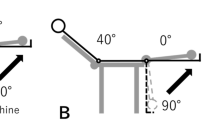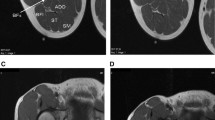Abstract
The effect of local isometric exercise on hand and forearm blood flow was studied. With maximum muscular exercise performed by both males and females, a decrease in hand and forearm blood flow was due to vasoconstriction caused by the mechanical pressure of working muscles. With 75 and 50% loads, marked hyperemia was observed in the main and microcirculatory vessels in the hand and forearm, which was rather long-lasting in the hand because of the difficulty of the forearm venous outflow. The minimum loads affected mainly the microcirculation, and no significant hemodynamic changes in main vessels were observed. The exercise performed at 50% of maximum muscular force was taken as an optimum load in kinesotherapeutic programs.
Similar content being viewed by others
REFERENCES
Smirnov, K.M., Fiziologicheskie issledovaniya na proizvodstve v razrabotkakh po okhrane, organizatsii i gigiene truda. Metodicheskie rekomendatsii (Physiological Studies at Workplace in Research on Industrial Medicine and Labour Safety and Organization. Methodical Recommendations), Leningrad, 1984.
Tkhorevskii, V.I., Blood Supply to Antebrachial Muscles during Static Exercise of Different Strength and Duration, Fiziol. Zh. SSSR, 1968, vol. 54, no. 2, p. 199.
Seredenko, M.M., Minyailenko, T.D., and Pozharov, V.P., Specific Features and Compensation of the Secondary Tissue Hypoxia during Muscular Activity, Fiziol. Chel., 1987, vol. 13, no. 5, p. 83.
Kutuzova, A.E., Perepech, N.B., Evdokimova, T.A., and Nedoshivin, A.O., Hemodynamic Response to Isometric Exercise in Healthy Subjects with Different Types of Circulation, Fiziol. Chel., 1995, vol. 21, no. 2, p. 74.
Abe, E., Intramuscular Pressure and Muscle Blood Flow during and after Contraction, Nippon Seikeigeka Gakkai Zasshi, 1981, vol. 55, no. 4, p. 399.
Mitsuno, M., Khorn, A., Zekher, N., and Kvistorf, B., The Study of Metabolic Characteristics of Slowly and Quickly Contracting Fibers in Human Skeletal Muscle by Means of Nuclear Magnetic Resonance Spectroscopy 31 R, Fiziol. Chel., 1993, vol. 19, no. 1, p. 34.
Koryak, Yu. A., Training Effect of High-Frequency Electrical Stimulation on Anterior Tibial Muscle in Human. I. Effect on Muscular Force and Cross-Sectional Area, Fiziol. Chel., 1993, vol. 19, no. 1, p. 19.
Tsyrkunov, M.B., Compensation and Mobilization of Knee Joint by Means of Functional Therapy in Case of Damaged Capsuloligamentous Structures, Doctoral (Med.) Dissertation, Moscow, 1997.
Lioznova, E.A. and Lioznov, M.V., The Structure of Hemodynamic Response to Isometric Exercise Depending on the Initial Level of the Arterial Pressure, Fiziol. Chel., 1994, vol. 20, no. 2, p. 73.
Lamid, S. and Wolff, F., Drug Failure in Reducing Pressor Effect of Isometric Handgrip Stress Test in Hypertension, Amer. Heart J., 1973, vol. 86, no. 2, p. 211.
Author information
Authors and Affiliations
Rights and permissions
About this article
Cite this article
Novikov, A.V., Lavrov, M.N. The State of the Regional Blood Flow in the Upper Extremity after Dosed Physical Exercise. Human Physiology 28, 310–316 (2002). https://doi.org/10.1023/A:1015508919517
Issue Date:
DOI: https://doi.org/10.1023/A:1015508919517




